Because of the fluidity of the desert war, large amounts of enemy ammunition weapons and ammunition were captured making the use of enemy weapons more possible than under normal circumstances. Numerous enemy weapons were used by the LRDG, however they were not used in favor of British weapons. They weapons were normally issued for a specific mission and returned once the mission was over. Of course, it was common for soldiers to sometimes keep captured weapons as a souvenir but this was not common or according to regulation. Pistols were more likely to be souvenirs than other weapons. The only enemy weapon used regularly by the LRDG was the Breda Model 35 20mm cannon. Enemy small arms were not routinely carried by the LRDG.
Among the most commonly used enemy weapons were Italian and German Service pistols. Italian and German submachine guns and machine guns were also highly prized.
The best Italian machine gun was the Model 37 Breda (or the M38 tank variant). The most common German machine gun was the MG34. Both machine guns were reliable and robust.
With the exception of the Italian Light machine guns, there is a common misconception that Italian small arms were inadequate or inferior. Most were reliable and robust. The main problem with Italian small arms was in the non-standardization of caliber. Italian pistols and submachine guns could not share ammunitions. The chart below marks what ammunition different weapons used.
| Weapon | 9mm ACP (pistol) |
9mm Parabellum (pistol) |
6.5mm (rifle) |
7.35 mm (rifle) |
8 mm (rifle) |
| M34 pistol | xx | ||||
| M38 SMG | xx | ||||
| M91 Rifle | xx | ?? | |||
| M30 Lt MG | xx | ?? | |||
| M37 MG | ?? | xx | |||
| M38 MG | xx |
The Italians had planned to adopt the 7.35 mm round for use in all rifles and machine guns and a few rifles and machine guns were made in this caliber in 1940 but the production ceased because of the war. The 6.5 mm round was adequate at stopping personnel but was considered under strength for use as a machine gun round. It lacked penetration power even against lightly armored vehicles or fortification.
With the exception of the 7.63 Mauser round, most German weapons used either the 9mm Parabellum for pistols and submachine guns and the 7.92 mm Mauser round for rifles and machine guns. the 7.92 Kurz (short) round was introduced in 1943 for use with assault riffles.
The following are examples of Enemy weapons that were found favorable by allied forces operating in the desert campaign. It is not a complete listing of all axis weapons. While the German Mauser rifle (98K) was an excellent rifle, it was not preferred over the SMLE. Indeed few armies seemed to prefer another army's rifle over their own.
Pistols
M1934 (Beretta)
Probably the best known and best quality pistol produced for the Italian military during WWII was the M34 Beretta. The Military Beretta M1934 fired fired 9mm Short (38ACP) ammunition. While the 38ACP has less power than the Parabellum round it was at least as powerful as the British .380 SAA round used in their service revolvers.
If the pistol resembles the Walther PP, it is no accident. In 1930 the Italian Army was looking at the PP as a possible replacement for their current side-arm. the Beretta arms factory responded quickly to the rival and developed the M1934. The pistol was officially adopted by the Italian Army in 1937.
The pistol was also popular with German officers who liked the light, robust pistol A version (M1935) was also produced in 32 ACP (7.65mm) but this was not the standard pistol used by the Italian Army. It was however commercially available in Italy and much of the Mediterranean.
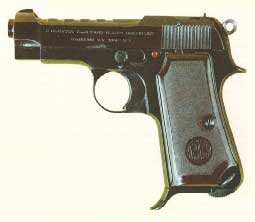
Basic characteristics
- Ammunition: 38ACP (9mm Short)
- Operation: Blowback, semi-automatic
- Length: 15 cm (6 inches)
- Barrel: 9.cm (3.75 inches )
- Weight: 0.6 kg (1.3 lbs)
- Magazine: 7
- Muzzle velocity: 251 mps (825 FPS)
- Effective range: 40m
P08 (Luger)
The four most common German pistols during World War II were the the P08, P38, PP, and Mauser. Of these pistols the Mauser was never officially adopted by the German Army but was used by some special units, and was widely used throughout the Mediterranean including Egypt.. The P08 or Luger was obsolete by WWII large numbers were still in use in the first half of WWII. The standard sidearm of the Wehrmacht was the Walther P38. A relatively heavy pistol, by today's standards, it was robust and very reliable. The Walther PP was a standard side arm for German police and also widely used with German paratroopers and tank crews.
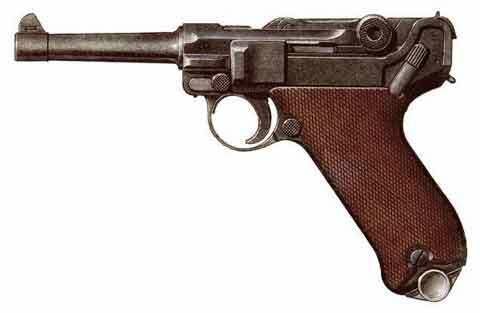
Basic characteristics
- Ammunition: 9mm Parabellum
- Operation: Short recoil, single action
- Length: 22cm (8.7 inches)
- Barrel: 10.5 cm (4.1 inches) *
- Weight: .09 kg (1.92 lbs)
- Magazine: 8
- Muzzle velocity: 317 mps (1,040 fps)
- Effective range: 50 meters
* Longer barrels were introduced as was a snail drum (32 round) magazine and shoulder stock but such versions were not used in WWII and were very rare.
The Luger is probably the most recognized pistol in the world and was one of the most sought after war souvenirs in both World Wars. By the start of World War II, the pistol was considered obsolete and was officially replaced by the Walther P38.
While the Luger was highly accurate and easy to fire it had two disadvantages as a weapon of war. It was not easy to maintain and was somewhat fragile compared to other military pistols. These disadvantages became very apparent during World War I.
Despite these disadvantages, the Luger remained in service with the German military throughout the war for two reason, the shortage of P38s and the fact that many German soldiers preferred the old pistol over other more modern P38.
German officers would also purchase Lugers for the personal side arm rather than use the issued P38.
C-96 or M 1895 (Mauser)
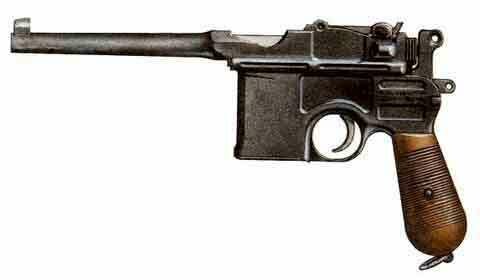
Basic characteristics
- Ammunition: 7.63mm Mauser
- Operation: Short recoil, semi automatic
- Length: 31 cm (12.2 inches)
- Barrel: 14 cm (5.5 inches)
- Weight: 1.2 kg (2.6 lbs)
- Magazine: 10 and later 20 integral
- Muzzle velocity: 425 mps (1,394 fps)
- Effective range: 200 meters
C-712 M32 (Schnellfeuer Mauser)
- Ammunition: 7.63mm Mauser
- Operation: Short recoil, Selective fire
- Length: 31cm (12.2 inches)
- Barrel: 14cm (5.5 inches)*
- Weight: 1.2kg (2.6 lbs)
- Magazine: 20, 40 round, detachable
- Muzzle velocity: 425 mps (1,394 fps)
- Effective range: 200 meters**
* Other longer barrel length were introduced in efforts to use the pistol with shoulder stock as a carbine
** The effective range dropped dramatically when fired full auto.
It is actually wrong to consider the C-96 Mauser as an Axis weapon because it was never officially adopted by the Germany. During WWI several were converted to 9mm Parabellum and pressed into military service. In WWII the M32 (7.63mm) version was used by the Waffen SS in large quantities but not officially adopted..
Most models of the C-96 Mauser were semi-automatic and possessed a integral magazine well loaded by strips of ammunition. The M32 Mauser adopted a detachable magazine feed and was also capable of full automatic fire. Many earlier c-96 pistols were converted to accept a detachable magazine.
As mentioned the C-96 Mauser was never officially adopted by the German Army (In fact only China ever officially adopted the pistol) However the pistol was widely available and very popular. Winston Churchill actually preferred it over other pistols.
Despite the lack of military adoption, the pistol proved very popular with territorial and colonial security forces. This was especially the case in the British Mandate of Palestine where Jewish paramilitary security forces adopted the pistol. It was also popular among colonial and territorial forces in Egypt and India. In most cases the caliber of choice remained the high velocity 7.63 Mauser, considered by many superior to other pistols rounds.
A wooden shoulder holster doubled as a stock allowing shoulder firing of the pistol. This was especially useful when firing the Schnellfeuer Mauser.
It is extremely unlikely the Mauser would be a captured souvenir. However it was readily available for purchase.
Walther PP (Polizei Pistole)
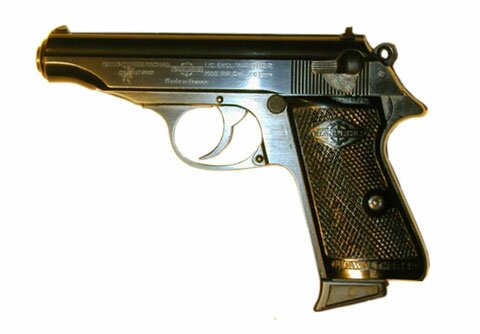
Basic characteristics
- Ammunition: 32 ACP (7.65mm)
- Operation: blowback, double action, semi-automatic
- Length: 173 mm
- Barrel: 4 inches (99 mm)
- Weight: 0.7 kg (1.5 lbs)
- Magazine: 8
- Muzzle velocity: 290m (951ft)
- Effective range: 40m
The Walther PP or Police Pistol was adopted in 1929 as the standard sidearm for the German Police. It was used extensively by the German police and also used by German paratroopers, tankers and other military personnel when the heavier P-38 was considered unnecessary.
While some version were made firing the 38ACP round the standard caliber was 32 ACP, a somewhat underpowered round for military use. Despite these limitations, the pistol was tough and reliable. A slightly smaller version was the PPK (Polizei-Pistole Krimminal or undercover police pistol) The PPK carried one less round and had a slightly shorter barrel which reduced the overall weight and dimensions. The PP was normally carried in a holster outside the clothing where as the PPK was designed to be carried concealed.
Submachine guns
MP38- MP40
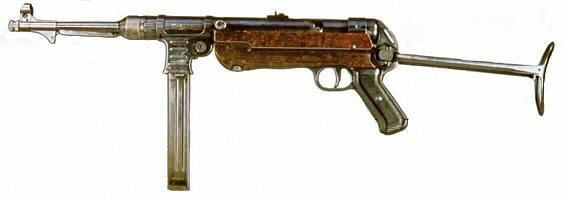
The MP38 and MP40 were the standard submachine guns for the German Army. Often called the Schmeisser because of a false belief that Schmeisser had designed the weapon, the weapon was popular with all armies. It was the basis for the British Sten. Firing 9mm Parabellum and weighing a hefty 8.7 pounds it was an effective weapon out to about 100 meters.
The MP40 was a simplification of the MP38 relying on stamped metal for many of the earlier machined parts. Both weapons were reliable and preferred over the Sten.
- Operation: Fully automatic
- Caliber: 9mm Parabellum (.354 in)
- Muzzle velocity: 380 mps (1247 fps)
- Capacity: 32-round magazine
- Weight: 3.97 kg (8.7 lbs)
- Overall length: 83.2 cm (32.75 in with stock extended)
- Rate of fire: 500 rounds per minute
- Effective range: 100m (110 yds)
Model 1938a (MAB or Moschetto )

While the German MP40 is the stuff of legends, the sometimes overlooked Italian counterpart the M1938a Beretta was considered a rough and reliable counterpart. The M1938a was not only issued to the Italian Folgore (parachute) division but also was widely used by German forces, including Kampfgruppe Menton and the Ramcke Brigade. The wooden stock gave the weapon a more conventional design but also made it more robust and aided in its accuracy.
This handy Italian SMG used a double trigger. The front trigger allowed single fire while the back trigger would fire fully automatic. This was also an advantage over the "automatic only" MP40
- Operation: Semi and full automatic
- Caliber: 9mm Parabellum (.354 in)
- Muzzle velocity: 429 mps (1407 fps)
- Barrel: 31.5 cm (12.4 inches)
- Capacity: 10, 20, 30, 40 round magazine
- Weight: 4.2 kg (9.2 lbs)
- Overall length: 94.6 cm (37.2 inches)
- Rate of fire: 600 rounds per minute
- Effective range: 200 meters (220 yards)
Because of the longer barrel, the muzzle velocity and accuracy of this nimble SMG outclasses the German MP40 and most other SMG of WWII.
Some sources claim that the ammunition used in the SMG could be used in the Beretta pistol. According to Jane's Pocketbook of Pistols and Submachine Guns, this is not the case. Not all 9mm rounds are the same.
Machine Guns
German MGs
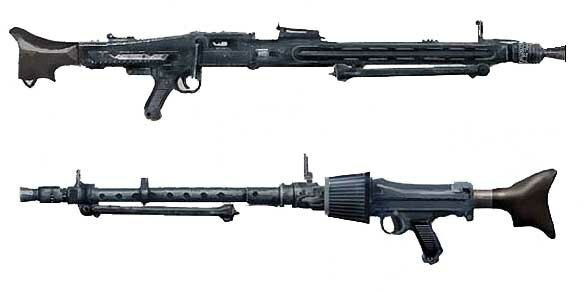
Due to restriction put upon Germany with the Versailles Treaty, they were limited to the number of heavy and medium MGs they could manufacture. In an effort to avoid the restrictions, the German, revolutionized the concept of the machine gun. Rather than manufacture different kinds of MGs the Germans developed what would later be known as a General Purpose Machine gun (GPMG) with the introduction of the MG34. The MG34 was later simplified by using stamped parts and new quick change method for its barrel and became the MG42. After the War the MG42 was rechambered and became the MG42/59 and still later the MG3. It is still in use today. The MG42 saw limited use in the desert campaign.
MG34 Characteristics
- Operation: Recoil
- Caliber: 7.92 mm (.31 in)
- Muzzle velocity: 762 mps (2500 fps)
- Feed: 50-100 round belts
- Weight: 12.1 kg (26.7lb)
- Length: 122 cm (48 in)
- Barrel: 62.7cm (24.7in)
- Rate of fire: 850 rounds per minute
- Effective range: 1,000m (1,100 yds)
MG42 Characteristics
- Operation: Recoil, Fully Automatic
- Caliber: 7.92 mm (.31 in)
- Muzzle velocity: 820 mps (2,690 fps)
- Feed Type: 50 and 250 round continuous link metal belts
- Weight: 11.6 kg (25.6 lb)
- Length: 122 cm (48 in)
- Barrel: 62.7cm (24.7in)
- Rate of fire: 1,200- 1,500 rounds per minute
- Effective range: 1,000m (1,100 yds)
The M37 Breda
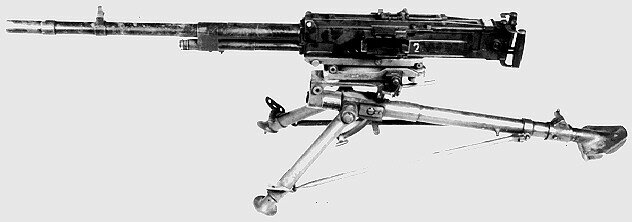
The M37 Breda was one of the two reliable Italian MGs, the other being its vehicle mounted cousin the M38. The M37 was strip fed while the M38 was magazine fed from the top. The M37 had twin spade handles and the M38 a pistol grip.
While the M37 was a good machine gun, it had its problems. The 20 round strips needed to be oiled to prevent the gun from jamming. This was a distinct problem in the desert as the oil attracted dust, which could also cause the weapon to jam. An oddity of the weapon was that once the round was fired it was reinserted into the stripper clip.
The tank mounted M38, fired from a 24 round top mounted magazine used a pistol grip and had a shorter barrel. After recognizing the value of the gun, the Italians began attaching offset iron sights and using the M38 in a ground role.
Modello 37
- Operation: Gas, full automatic
- Caliber: 8mm
- Muzzle velocity: 900 mps (2953 fps)
- Feed: 20 round strips
- Weight, w/o tripod: 17.5 kg (38.5 lbs)
- Length: 127 cm (50 inches)
- Barrel: 72cm (28 inches)
- Rate of fire: 460 rounds per minute
- Effective range: 1,000m (1,100 yds)
Modello 38
- Operation: Gas, full automatic
- Caliber: 8mm
- Muzzle velocity: 762 mps (2500 fps)
- Feed: 24 round box magazine
- Weight, w/o tripod: 17.5 kg (33.9 lbs)
- Length 90.2cm (35.5 inches)
- Barrel 58.4 cm (23 inches)
- Rate of fire: 600 rpm
- Effective range: 1,000m (1,100 yds)
Read more about weapons:
